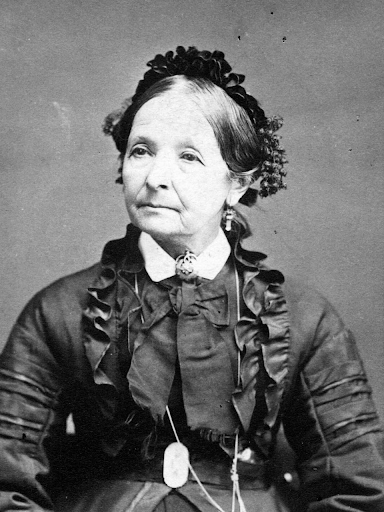To sign up for our daily email newsletter, CLICK HERE
Joseph Smith was the founder of The Church of Jesus Christ of Latter-day Saints (LDS or Mormon Church). One of the more controversial aspects of the LDS Church was polygamy. Various church members practiced polygamy from the 1840s to 1890, when the practice was ended by the fourth president of the church. The founder of the church, Joseph Smith, practiced polygamy during his lifetime, which some people believe to be a significant problem with his character and claim to be a prophet. Some even criticize the women he married or degenerate Joe Smith’s wife’s names by calling them ignorant, manipulated, or subservient. However, many of his plural wives have fascinating stories and backgrounds. Here, we explore the lives of a few of these women:
Fanny Alger
Fanny Alger is often considered Joseph Smith’s first plural wife. Born on September 30, 1816, in Massachusetts, Fanny moved to Kirtland, Ohio, with her family, who were early converts to the LDS Church. Around 1833, she became a servant in the Smith household. The exact date of her marriage to Joseph Smith is debated, but it likely occurred around 1835. The marriage was kept secret, and it caused considerable controversy when it was later discovered. Some contemporaries described their relationship as an affair, while others believed it was a legitimate marriage sanctioned by divine revelation.
Louisa Beaman
Louisa Beaman was born on February 7, 1815, in Massachusetts. She married Joseph Smith on April 5, 1841, in Nauvoo, Illinois, in a ceremony conducted by Joseph Bates Noble, who was her brother-in-law. Louisa’s marriage to Joseph is significant as it was among the first to be openly acknowledged within the inner circle of the LDS leadership. After Joseph’s death, Louisa continued to be a faithful member of the church and married Brigham Young, the second president of the LDS Church.
Helen Mar Kimball
Helen Mar Kimball, born on August 22, 1828, in Mendon, New York, was Joseph Smith’s youngest wife. She was married to Joseph in May 1843 when she was just 14 years old. This marriage was reportedly proposed by her father, Heber C. Kimball, a close friend and follower of Joseph Smith. Helen later wrote extensively about her experiences and the early days of the LDS Church, providing valuable historical insights. Her writings reveal the complexities and challenges of polygamous life, especially for young brides, but she would defend her marriage to Joseph Smith for the rest of her life.
Eliza R. Snow

Eliza R. Snow, born on January 21, 1804, in Massachusetts, was a prominent poet, writer, and leader within the LDS Church. She married Joseph Smith in June 1842. Eliza’s marriage to Joseph was part of her broader commitment to the principle of plural marriage. After Joseph’s death, Eliza became a wife of Brigham Young and continued to play a significant role in the church, notably as the second general president of the Relief Society, an organization for women within the LDS Church. She is remembered for her contributions to church hymns and her strong leadership.
Zina Diantha Huntington
Zina Diantha Huntington was born on January 31, 1821, in Watertown, New York. She married Joseph Smith on October 27, 1841, in Nauvoo. Zina’s marriage to Joseph was complicated; she was also married to Henry Jacobs at the time, making her situation unique among Joseph’s plural wives. After Joseph’s death, Zina continued her marriage to Jacobs but later married Brigham Young. Zina became a prominent leader in the LDS Church, serving as the third general president of the Relief Society.
Lucy Walker
Lucy Walker, born on April 30, 1826, in Vermont, married Joseph Smith on May 1, 1843, in Nauvoo. Her marriage to Joseph occurred after her family had become close to the Smiths. Lucy’s father was sent on a mission by Joseph, and during that time, Lucy and her siblings lived with the Smith family. Lucy’s accounts of her marriage to Joseph reveal the emotional and spiritual challenges she faced but would defend Joseph Smith’s polygamy for the rest of her days. After Joseph’s death, Lucy married Heber C. Kimball and remained a devoted member of the LDS Church.
Emma Hale Smith
While Emma Hale Smith was Joseph Smith’s first and only legal wife, her experiences with Joseph’s practice of polygamy are significant. Born on July 10, 1804, in Harmony, Pennsylvania, Emma married Joseph Smith on January 18, 1827. She supported Joseph throughout his early prophetic career but struggled deeply with the practice of polygamy. Records show that Emma supported Joseph Smith’s plural marriages to some women. However, she later became opposed to the practice. Emma’s opposition to polygamy created tension in their marriage and within the church.
After Joseph’s death, Emma did not follow Brigham Young and the main body of the church to Utah. Instead, she remained in Nauvoo, Illinois, and later supported the Reorganized Church of Jesus Christ of Latter Day Saints (now Community of Christ), led by her son Joseph Smith III. She would deny that Joseph Smith ever practiced polygamy for the rest of her life and often stated that Brigham Young had instituted the practice.
Conclusion
These women’s lives illustrate the complexity and diversity of experiences among Joseph Smith’s plural wives. Each played a unique role in the early LDS Church, facing challenges and making significant contributions to the faith. Their stories provide valuable insights into the practice of polygamy and the early history of the LDS Church.